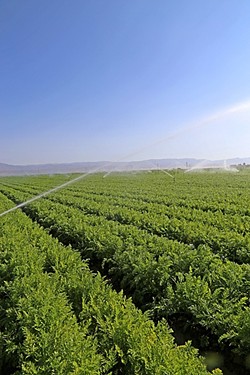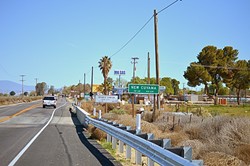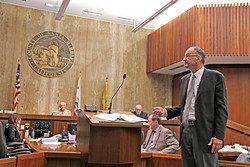Cuyama Valley is the “gem” of carrot growing regions. It’s got that fertile soil with all the right minerals and nutrients. It’s got that climate with hot days and cool nights.
Grimmway Farms has plucked little orange jewels—and other veggies—out of the arid region for more than 30 years, and Bolthouse Farms coaxes those fern-topped root veggies to life on much of the 4,000 acres of land it farms in the valley.

- PHOTO BY DYLAN HONEA-BAUMANN
- WALL-TO-WALL AGRICULTURE: Farming in the Cuyama Valley began a little more than half a century ago. Inefficient irrigation practices led to the state declaring Cuyama’s groundwater basin to be critically overdrafted.
You could say carrot is king in the dusty, remote region split between Santa Barbara, San Luis Obispo, Ventura, and Kern counties, and the queens of carrots farm there. But wine grapes, olives, pistachios, and lettuce also paint shades of green onto the desert landscape.
The only thing the growing region seems to be having a hard time with is water. Every living being in the valley quenches its thirst from the same water source—the Cuyama Valley Groundwater Basin, a resource that’s rapidly disappearing.
Jim Wegis is the owner of Triangle E. Farms, which sits near the small, unincorporated town of Ventucopa. Although his family has been in the Cuyama Valley for roughly 150 years, Wegis has been farming his current property for less than four decades.
He feeds his crops with two wells—one of which recently went dry—that tap into the groundwater basin deep below the valley.
“When we first started hearing about all of these water problems, we changed our focus,” Wegis told New Times. “I’m 69 years old, and I have to cut back on what I have to do.”
The roughly 1,100 residents of New Cuyama are thirsty, too. With the valley’s only source of water being used up twice as fast as the basin can recharge, a proposal for the formation of a local water district composed of landowners—including big agriculture—is being met with opposition from residents and smaller landowners who also depend on the same basin.
The opposition comes because Cuyama’s groundwater basin is in a state of “critical overdraft,” a designation given by the California Department of Water Resources.
In September 2014, the state Legislature passed the Sustainable Groundwater Management Act that’s intended to protect California’s groundwater.
The act is meant to buffer the drought-stricken land with the state’s available groundwater. It allows for the formation of local water districts and requires them to come up with customized groundwater sustainability plans to fit their needs.
A petition by growers to form the Cuyama Basin Water District was approved by the Santa Barbara County Local Agency Formation Commission (LAFCO) 6-1 on Sept. 1, but there’s a lot of work left to do before the district can actually be formed. Growers fear that if a district is not formed by June 30, 2017, the state will impose restrictions they don’t want.
But residents and smaller landowners say they’re being left out of the process and fear that the rush to implement the district will leave them with inadequate representation and, at worst, without water for future generations.
The fears are comparable to the worries of the people who farm, ranch, and live over the Paso Robles Groundwater Basin, which also has overdraft problems. And although registered voters over that basin already voted down the formation of one water district earlier this year, two new Paso basin water district proposals are currently rolling through San Luis Obispo County—but at least one landowner gives Cuyama better odds for successful water district formation than either of those being proposed in Paso.
The ‘largest ever’ district
Encompassing more than 83,000 acres, the proposed Cuyama water district would be what Paul Hood calls the “largest ever” in his 30 years as Santa Barbara County LAFCO executive director.
Even though Cuyama’s dry soil spreads into four counties, Santa Barbara County LAFCO is taking the lead in forming the district since most of the land sits within that county.
Thirty-six landowners who occupy roughly 71 percent of the land within the proposed district signed the petition to form the district. Some of them include large farming operations like Grimmway and Bolthouse—a subsidiary of Campbell Soup Company. LAFCO reports that there are 250 landowners in the proposed district, and approximately 20 of those have active irrigated farming operations.
Even though it technically wouldn’t have the power to manage the groundwater—which is the job of the state Water Resources Control Board—the proposed district would have the power to “administer, develop, construct, and operate projects and programs” that would stabilize the basin, according to Ernest Conant, a prominent Bakersfield water attorney who’s heading up the petition for the landowners. Conant has more than 30 years of experience in dealing with such issues.
The landowners want the district because they use most of the irrigated water in the valley and say they’ll be most affected by groundwater restrictions.
“Naturally, landowners want to be represented,” Conant said. “They have the long-term interest in seeing what’s balanced. It’s only fair that these people who are going to be most affected, that they be represented and get a seat at the table.”
One of those landowners is 82-year-old Fred Reyes, owner of Walking R Ranch. Reyes has been ranching cattle in the same location at the mouth of the Santa Barbara Canyon since 1945 and is the descendant of one of the original Spanish land grantees from the early 19th century. He was in Cuyama before farming ever existed and has witnessed the gradual draw down of water.
According to the U.S. Geological Survey, the Cuyama Valley’s irrigated acreage has increased from 13 to 35 percent of the valley since 1949, and up to 72 percent of the groundwater has been depleted in the main area of the basin. There are portions of land over the basin that are sinking because of how little groundwater is left below them.
“A lot of springs have dried up,” Reyes said. “You can’t put cattle where there’s no water.”
Although only a portion of his land sits within the proposed district, he echoes many sentiments of the landowner petitioners about what’ll happen if the district isn’t formed before the deadline.
“The state government will come in and make its own rules,” he said.
If formed, the district will comprise only landowners or their representatives and participate in a groundwater sustainability agency that could possibly include the Santa Barbara County Water Agency, the other three counties, and the Cuyama Community Services District (CCSD), which provides sewer and water to New Cuyama residents. That agency will come up with the plan to sustainably manage the Cuyama basin.
One acre, one vote
The biggest rattle in the district opponents’ cage is one acre, one vote. Basically, Bolthouse Farms gets 4,000 votes if all of its acreage happens to be in the district. And Gene Zanon with the Santa Barbara Pistachio Company would get a few hundred. And if you owned a house on rural land over the basin that took up less than 1 acre of land, you would only get one vote with which to elect your representatives.

- PHOTO BY DYLAN HONEA-BAUMANN
- CUYAMA COMMUNITY: New Cuyama, a town of roughly 1,100 residents that gets its water from the Cuyama Community Services District, would be excluded by the proposed water district even though some say it taps into the same aquifer.
State law allows one vote per acre of land, rather than one person, one vote—which is viewed as undemocratic to some of the residents and the small landowners who submitted their own petition with more than 100 signatures opposing the district.
That system, although it’s the way hundreds of water districts have been formed in the state through California water law, is what caused Santa Barbara County 3rd District Supervisor Doreen Farr to be the lone vote against the district’s formation at the Sept. 1 LAFCO hearing.
“The acreage in this area is not evenly distributed. … I’m not opposed to the formation of a district; just not this district,” she said. “To me, it’s giving a large group of landowners a voice.”
Farr said she is a proponent of using registered voters to create the district. A district like that would have put the largest landowner in Cuyama, Caliente Ranch, on the bench, because while Ann Myhre and other members of her family own ranching land (not irrigated) in the valley, nobody lives there. And that’s exactly what happened during the fumbled attempt at forming a Paso water district earlier this year.
Myhre said she and her sister own land outside of Shandon, but Myhre lives in Monterey County while her sister lives in Paso Robles. So although they owned land in the proposed district, they didn’t get a chance to vote on its formation because of the special legislation that pushed the district forward. The whole proposal was complicated, but simply put, Myhre said it only gave registered voters a say in whether to form the district, even though landowners would have been burdened by the cost of financing said district.
“The rhetoric got so emotionally charged, I think that was one of the problems,” she said of the issues that plagued Paso’s proposal. “That hybrid district, I think everyone looks back at that and believes it was a mistake. It’s hard after a loss like this to regroup.”
That being said, the two proposals on the table right now over the Paso basin are opt-in, one-acre, one-vote districts. One is farther along in the LAFCO process than the other. The Shandon-San Juan Water District would contain 77,000 acres of land between highways 58 and 46, and SLO County LAFCO is currently verifying the signatures on the petition. The Estrella-El Pomar-Creston Water District would cover 100,000 acres of land over the Paso basin, and a group of large landowners gave the county notice that they are circulating a petition.
If the districts are approved, landowners have the option to not participate in whichever district their land is contained within, so they wouldn’t be subject to financing the district.
However, David Church, SLO County LAFCO’s executive director, said every landowner that overlies the basin will have to follow what’s outlined in the water management plan decided on by the groundwater sustainability agency the districts hope to participate in.
Myhre said she’s unsure about whether she will support the Shandon district.
“I’m waiting to see how much support it gets,” she said. “I’m a little concerned because the same people who were behind the one that failed are behind this one; it might be a good thing and it might not—I don’t know.”
But she’s confident that the one in Cuyama will make it through to the other side of the process, which will involve forming a board to oversee the water district, a vote on funding the district, and signing a joint powers agreement with other members of the groundwater management agency that will ultimately make decisions on what to do about the Cuyama Valley Groundwater Basin and its overdraft problems.
She feels that the Cuyama Valley is less complicated than what’s happening over the Paso basin, it’s not as politically charged, and that a higher percentage of landowners support the proposed district. She acknowledged that she can see why smaller landowners are worried about what will happen with their water, but she said proponents of the district don’t intend to pull water out of the basin to the detriment of other residents.
“That’s not the intention of the farmers to do that, I can tell you for sure,” Myhre said. “But even if that was the intent, it wouldn’t be allowed.”
The county and the state will have oversight of the whole process, she added.
Former CCSD member and New Cuyama resident John Mackenzie—a vocal critic of the proposed district—likens the district to that of a private cartel that has the power of a public agency that’s being fast-tracked to avoid opposition.
“This is a fast-moving train,” Mackenzie told the LAFCO commissioners at an Aug. 5 hearing. “You’re being asked to do your part to maximize the interests of a private interest group. Santa Barbara County will bear the consequences.”
Long time coming
According to Randy Hanson, a hydrologist with the U.S. Geological Survey (USGS) in San Diego, the aquifer’s current level is a result of decades of pumping, the peak of which came in the 1970s and 1980s with inefficient irrigation practices, and when water-intensive alfalfa was the main cash crop.

- PHOTO BY DYLAN HONEA-BAUMANN
- LANDOWNERS' ATTORNEY: Ernest Conant is a Bakersfield-based attorney who’s leading the charge for the proposed Cuyama Basin Water District comprised of landowners who will be most affected by recent California laws in groundwater management.
Now, decades of over-pumping have caused some parts of the valley to sink as much as a quarter inch, Hanson said, and it could ultimately affect road surfaces, fields, or even gas pipelines.
In fact, Hanson said that some growers are pumping so deep (as much as 1,000 feet in some spots), that they’re pulling water that’s between 10,000 to 30,000 years old—or as old as the last Ice Age. When you go that deep, he said, the water contains things such as arsenic, which isn’t fit for human consumption.
Agriculture in the Cuyama Valley historically uses more water—a lot more—than what’s consumed by residents in the CCSD. To complicate things even more, a 2014 study conducted by the USGS found that the Cuyama basin is actually composed of several sub-regions each with their own water availability, yet it’s unclear how interconnected they are.
“The thing about the valley is that it’s structurally three major different regions,” Hanson told New Times. “They [Cuyama] have to realize that their region has multiple aquifers that will have to be managed differently with respect to the overarching context of what they want to do to sustain their resources.”
Triangle E. Farms landowner Wegis believes different sub-regions ought to be managed separately.
“Up in the Ventucopa basin, we feel that we need to be treated somewhat differently,” Wegis said. “If they’re going to put us all in one pot and we have to cut water by 50 percent, we don’t feel that’s fair because our water table doesn’t have to raise that much.”
Adding to the problem is funding the new district, which is contingent on Proposition 218—a voter-approved measure passed in 1996 that requires the majority of tax- or ratepayers to vote on new or increased taxes in local jurisdictions. A majority of its landowners would need to vote on a funding model that would pay for the district by the May 2017 LAFCO meeting or the newly formed district would automatically dissolve.
According to Conant, the Sustainable Groundwater Management Act process will be expensive. Santa Barbara County was awarded $249,240 last March for the formation of a Cuyama Valley groundwater sustainability agency, according to state records provided to New Times by the Department of Water Resources.
Although the district was approved, it still goes to a vote before the Santa Barbara County Board of Supervisors. If denied, there’s always the possibility of litigation.
Either way, growers are already accepting the grim possibility of fallowing parts of their land.
“It’s going to change a lot of our community,” Grimmway’s Patricia Poire said at the August LAFCO meeting and reiterated in September. “They realize they have to fallow land and it will impact family and employees.”
Contact Staff Writer David Minsky from New Times’ sister paper at [email protected]. New Times’ Editor Camillia Lanham contributed to this article.
Comments (2)
Showing 1-2 of 2